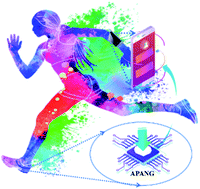Highly stretchable, recyclable, notch-insensitive, and conductive polyacrylonitrile-derived organogel†
Abstract
Advanced stretchable and wearable electronic devices have a great potential in the fields of motion detection, health monitoring, and artificial intelligence, substantially increasing the demand for elastic materials. This study reports a novel stretchable, recyclable, notch-insensitive, and conductive material based on amidoximated polyacrylonitrile gel (APANG), which is an elastic substrate, for use in flexible electronics. APANG is prepared by straightforward nucleophilic addition, followed by solidification. APANG exhibits excellent stretchability with a strain of ∼800% and a high fracture energy of 12.92 ± 2.23 kJ m−2 because of a large number of hydrogen bonds among amidoxime groups on polymer chains and among the amidoxime groups and N,N-dimethylformamide molecules. Moreover, due to the reversibility of physical entanglement and dynamic hydrogen bond of polymer chains, the gel can be recycled, thereby avoiding the reprocessing issue of many conventional chemically crosslinked polymer gels. In addition, the existence of free chloride ions in the gel provides good conductivity to the materials. Finally, APANG exhibits good responsivity, recoverability, and reliability as strain sensors, demonstrating its great potential in stretchable and wearable electronic devices.



 Please wait while we load your content...
Please wait while we load your content...